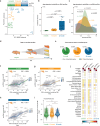EccDNA atlas in male mice reveals features protecting genes against transcription-induced eccDNA formation
- PMID: 39984484
- PMCID: PMC11845583
- DOI: 10.1038/s41467-025-57042-y
EccDNA atlas in male mice reveals features protecting genes against transcription-induced eccDNA formation
Abstract
eccDNA is a driver of many cancers and a potential intermediate in other age-related disorders. However, little is known about the mechanisms underlying eccDNA formation in healthy tissue and how aging affects these processes. Here, we present an atlas of eccDNA across seven tissues of male mice spanning four ages. EccDNA correlates with open chromatin characterized by signatures of H3K27ac and H3K4me1. Additionally, the mutational load of eccDNA on genes correlates with tissue-specific transcription and increases logarithmically as a function of transcript level. Still, a population of intron-dense genes with many splice forms remains sheltered from eccDNA formation. We also find that the total number of eccDNA molecules does not increase as mice age, unlike other types of mutations. Our data reveal a link between eccDNA formation and transcript level that may drive gene architecture in mammals.
© 2025. The Author(s).
Conflict of interest statement
Competing interests: B.R. is co-founder of CARE-DNA. X.L., Y.Q., P.H. are funded by Qingdao-Europe Advanced Institute for Life Sciences (QEI). J.M., Y.L., H.L. are or were employed by BGI. G.A., L.A.-G., J.M.H., S.H., A.R.-H., and H.P. declare that they have no known competing interests.
Figures




References
MeSH terms
Substances
Grants and funding
LinkOut - more resources
Full Text Sources

